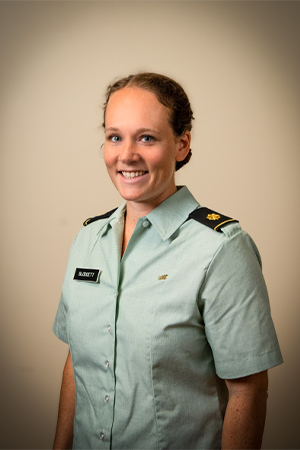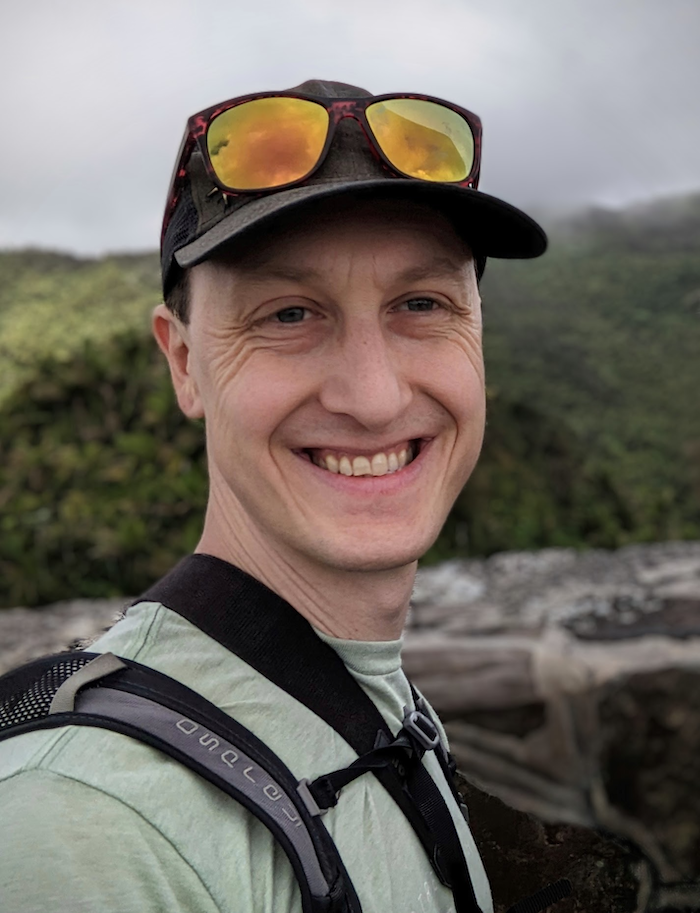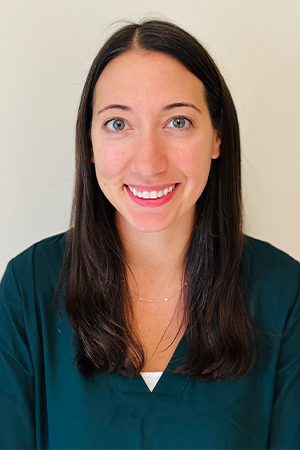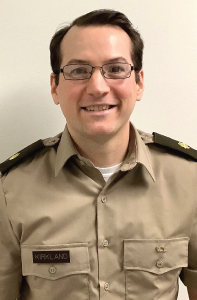Baccalaureate Partner Institutions (BPIs)
Research Coordinators

Dr. Mark Lubkowitz
Lead Coordinator / St. Michael's College, Department of Biology

Dr. Rick Bunt
Middlebury College

Dr. Andrew Vermilyea
Vermont State University - Castleton, Jeffords Center

Dr. Robert Cluss
Middlebury College, Department of Chemistry and Biochemistry

Dr. Greg Petrics
Vermont State University - Lyndon and Johnson

Dr. Darlene Olsen
Norwich University, Associate Professor Mathematics
2024 - 2025 Funded Faculty
| Name | Award Category | Title | ||
 | Kylie Blodgett Norwich University Faculty Bio | INBRE Faculty Project Award | "Developmentally Assessing Resilience as a Mediatory of Stress and Health Behaviors in College Students" | |
|
Summary of Research Project:
Obesity is an expensive problem in America. Young adults in college are at risk for obesity because they have high stress, poor diet and exercise behaviors, and low sleep. In addition, obesity is a major disqualifier for military service, and costs the military millions of dollars annually in medical care. Resilience may be related to improvements in stress and how health behaviors develop in college and military settings, helping reduce the risk for obesity. This research seeks to assess the development of stress, diet, physical activity, and sleep behaviors over time in students at a private military college and understand the role resilience may play in how these behaviors develop. Background/Training:Blodgett earned her Ph.D. in Health Education and Promotion from Walden University and is a Certified Health and Education Specialist. Her current work is on assessing the physiological, behavioral, and social needs of students at Norwich University and developing and implementing interventions to improve resilience, mental and physical health. She holds a Master of Science in Nutritional Sciences from the University of New Hampshire, where she studied the effects of polybrominated diphenyl ethers on fatty acid metabolism. She also holds a Master of Science in Kinesiology from the University of Michigan, where she studied the effects of exercise timing on circulating acylated ghrelin levels. Student Involvement in Research:Blodgett includes sophomore Health and Exercise science students enrolled in Health Science Research Methods (approximately 35 per Fall semester) in saliva collection. The following students have served as research apprentices and assistants on this project: Tara Grogan (’23, Health Science), Reny Ortega-Cotto (’24, Health Science), Molly Yacavoni (’25, Health Science), Kirsten Atuhaire (’26, Computer Security – Information Assurance), Abigail Chauvin (’25, Health Science), Ashley Parker (’26, Biology Current Collaborations:THRiVe Study with Dr. Rachele Pojednic, Resilient Bodies Intervention with Dr. Amy Welch. Potential Impact of your Research on Human Health and Beyond:The VBRN-funded study will facilitate data collection in a longitudinal observational study to assess health status, health-related behaviors, and resilience of students throughout their time at Norwich University. This will be used to 1) improve the Resilient Bodies intervention, 2) inform additional intervention strategies that are needed to improve resilience, mental, and physical health of Norwich students, and 3) inform approaches to specifically build resilience, mental, and physical health in military training environments. | ||||
 | Sam Byrne Middlebury College Faculty Bio | INBRE Faculty Pilot Award | "PFAS and mercury exposure from selfcaught fish consumption in Vermont" | |
|
Summary of Research Project:
This study aims to recruit approximately 200 individuals to complete a survey about consumption of locally caught fish. From within this group, we will recruit approximately 30 individuals to donate biological samples including blood and hair. We will assess then generate pilot data on the relationship between fish consumption and PFAS body burden. Background/Training:I have a PhD in Environmental Health Sciences from the University at Albany School of Public Health. Student Involvement in Research:Two undergraduate research assistants will contribute to the success of this research project over summer 2024, and one will continue through the academic year. Over the summer, research assistants are taking the lead on enrolling study participants and conducting initial surveys. Moving forward, research assistants will process and analyze human biological specimens as well as conduct data analysis and interpretation. Current Collaborations:For the last decade, I have been part of an interdisciplinary team of scientists working with Yupik Communities on Sivuqaq (St. Lawrence Island), Alaska to investigate exposure to persistent organic pollutants (POPs) and their subsequent health impacts. This work is funded by two NIEHS grants, and involves researchers from Emory University, Northern Arizona University, the University of Arizona, and the University at Albany. Potential Impact of your Research on Human Health and Beyond:Per- and polyfluoroalkyl substances (PFAS) are a serious threat to human health and the environment. The potential for exposure via fish consumption is understudied and is likely an important contributor to overall PFAS body burden in individuals that consume local fish. Recent PFAS spills impacting the Winooski River highlight the urgency of this research. | ||||
 | Andrea Corcoran Vermont State University Castleton Faculty Bio | INBRE Faculty Project Award | "Effect of Chronic Cannabidiol on the Cardiorespiratory System and Exercise Responses" | |
|
Summary of Research Project:
Recent polls indicate that 14-33% of Americans and at least one third of Vermont state’s population has used hemp-based products such as Cannabidiol (CBD). This non-psychoactive compound is one of 700 chemicals derived from the Cannabis sativa plant and is both legal and widespread for distribution in many states, including Vermont. The central hypothesis of this research is that chronic use of CBD favorably affects the cardiorespiratory system and this will be evidenced by elevated heart rate variability (HRV) and improvement in exercise performance and recovery compared to non-CBD users. Background/Training:I have a broad background in the neural control of breathing and in physiology, having used several different techniques and approaches to understand the mechanisms underlying respiratory control, particularly as it relates to homeostatic regulation. In my undergraduate, I studied both the role of development and species on physiological responses to temperature. My graduate work (both Masters and PhD) focused on central control, particularly as it related to chemoreception. As a postdoctoral fellow, studying the underlying pathophysiology of Sudden Infant Death Syndrome in rodent models, I performed whole-animal metabolic measurements looking at the role of serotonin and GABA in cardiovascular and respiratory responses to hypoxia, hypocapnia, hypercapnia, and temperature. This approach allowed me to pursue scientific questions using many techniques that were particularly amenable to undergraduate student education. In my first three years as an Assistant Professor at Castleton University, I was able to translate many of these methods and techniques to human physiology studies. I have mentored 12 undergraduate students in my research lab where we have been working to provide foundational data investigating the role of CBD on autonomic function and cardiorespiratory control in humans, and how these might be altered by varying levels of exercise. This project provides an excellent opportunity for undergraduate students to be involved in data collection and to introduce them to analysis and interpretation. Student Involvement in Research:Students have recently presented their VRBN-funded work at two international meetings: Zac Razanouski presented “The effects of acute cannabidiol on autonomic balance” at Experimental Biology 2022 (Philadelphia, PA) and Wayne Alexander presented “CBD use tendencies in rural versus urban Vermonters” at ACSM 2023 (Denver, CO). Current Collaborations: Potential Impact of your Research on Human Health and Beyond:As the number of products containing CBD increase and become more available, it is important that human subject studies are conducted to investigate CBD’s physiological effects on autonomic balance and exercise performance. The outcomes of this research have the potential to uncover therapeutic effects, and alternatively influence packaging warnings. This project will also explore the impact of chronic use of CBD where it may have the potential to provide cardiovascular benefits. | ||||
 | Jennifer Crodelle Middlebury College Faculty Bio | INBRE Faculty Project Award | "The Role of Inhibitory Plasticity During Development in the Formation of Orientation Preference Maps" | |
|
Summary of Research Project:
The communication among brain cells underlies everything we see and do, but the particular network structures that process information are unknown. During development, through a process called synaptic plasticity, these complex network structures are formed in part through rules dependent on the activity of the cells. I aim to use a mathematical model to investigate different experimentally-measured descriptions of plasticity rules and their effect on the resulting network structure. Background/Training:I earned my PhD in mathematics from Rensselaer Polytechnic Institute in 2017. My thesis project focused on detailed mathematical modeling of the activity of gap-junction coupled cortical neurons and the network-wide effect on synchrony. I spent three years as an NSF Mathematical Sciences Postdoctoral Research fellow at the Courant Institute, NYU working on modeling the interaction between gap-junction coupling and synaptic plasticity in the developing visual cortex. Student Involvement in Research:I employ and train mathematics students on reading neuroscience literature, constructing mathematical models of neuron activity, and computer coding skills to simulate the model and create figures displaying the results. Current Collaborations:I am not currently collaborating with other PIs on this particular project. Potential Impact of your Research on Human Health and Beyond:Identifying potential mechanisms underlying the formation of network structure of the visual cortex during development will aid in our understanding of potential diseases that disrupt this normal formation. One such disease is called Amblyopia, a neuro-developmental visual impairment that is caused by an imbalance of the visual input to the two eyes during development. Current strategies to treat Amblyopia include showing the affected eye an array of visual stimuli in an attempt to overwrite plasticity in development. A more detailed understanding of this plasticity from a mathematical model may lead to more targeted treatment plans. | ||||
 | Ruth Fabian-Fine St. Michael's College Faculty Bio | INBRE Faculty Project Award | "Age-dependent Degeneration of the Nervous System in an Invertebrate Model System" | |
|
Summary of Research Project:
We are investigating the cellular processes that take place in degenerating neurons of an invertebrate model system, the Central American wandering spider Cupiennius salei. The advantage of this model system is that these animals show similar degenerative processes to human neurodegeneration while the neurons in spiders are up to 10-times larger than those in humans. This allows for better observation of the underlying cellular causes. Utilizing our findings in spiders we compare the observed mechanisms with degenerative processes in human and rodent brain to investigate whether similar cellular processes can be observed. Background/Training:Originally from Frankfurt Germany I have completed my B.Sc., M.Sc., and Ph.D. in Biology/Neuroscience at Frankfurt University Germany. After completion of two postdoctoral positions in London England (Open University and National Institute for Medical Research) and Halifax Canada (Dalhousie University) I have accepted an Assistant Professorship at Saint Michael’s College in Colchester Vermont in 2015 where I was promoted to tenured Associate Professor in 2020. My expertise is in Cellular/Molecular Neuroscience, Developmental Biology and Toxicology. Student Involvement in Research:In collaboration with Dr. Adam Weaver our research team typically has between 15-22 students. Students are trained in histology, immunohistochemistry, Western blot analysis, light microscopy, confocal microscopy, quantitative analysis, Adobe Photoshop, ZEN Image processing, animal husbandry. Current Collaborations:We currently collaborate with Dr. Douglas Taatjes, Dr. Julie Dragon, Dr. Scott Tighe, Dr. Roxana Del Rio Guerra, Dr. Ying Wai Lam and staff of the University of Vermont CORE facilities on gene expression, protein identification and sequencing of the spider genome. Potential Impact of your Research on Human Health and Beyond:Due to their irreversible nature and in the absence of medical treatment options human neurodegenerative diseases inevitably end in death of the affected patients. Currently our knowledge regarding the underlying cellular mechanisms is limited. However, the development of treatment options critically depends on our understanding of the mechanisms that cause neurons to degenerate. Our goal is to drive our knowledge regarding cellular processes in neurodegeneration forward and contribute to the development of medical treatment options. | ||||
 | Sarah Gallant Norwich University Faculty Bio | INBRE Faculty Project Award | "Development of a Spectrophotometric Method for Detection of Uranium (VI) in Drinking Water" | |
|
Summary of Research Project:
This project aims to design a method for the detection of very low levels of uranium in drinking water, that can be completed by someone with little to no lab training. Short-term exposure to uranium in drinking water can result in weight loss or hemorrhages, while long-term exposure can result in kidney disease or cancer. A low cost, simple to perform method would increase access to and frequency of testing for potentially contaminated water. Background/Training:I completed my B.S. in Biochemistry at the University of Maryland, College Park, where I performed research in Iron Gall Ink in collaboration with the Library of Congress. Then I pursued my Ph.D. at Dartmouth College, where I investigated catalytic systems to generate new phosphine ligands using earth-abundant metal catalysts. I also generated a novel class of emissive materials from copper-phosphine complexes. This work in emissive materials gave me extensive experience in UV-Vis spectrophotometry, ligand synthesis, and metal complex synthesis and characterization. Student Involvement in Research:Currently, I have three students working in the laboratory over the summer, one rising sophomore and two rising juniors. They will be joined in the fall by another rising junior. Current Collaborations:I am collaborating with Dr. Seth Frisbie, Dr. Michael Prairie, and Dr. Emma Ste Marie to finish troubleshooting work on affordable UV-Vis spectrophotometers designed and built at Norwich University, and with Dr. Seth Frisbie and colleagues from MIT to design a new beta model of the spectrophotometer with a surface-mounted design. Potential Impact of your Research on Human Health and Beyond:A recent Annual Report to the Nation on the Status of Cancer featured data indicating a 50% increased likelihood of kidney cancer for Native Americans due to uranium exposure. In addition, a recent study by researchers from the University of Nebraska-Lincoln, two aquifers in the United States that serve nearly 6 million people contained groundwater uranium exceeding the U.S. Environmental Protection Agency maximum contaminant level. The objective of this research is to prevent uranium exposure through low levels in drinking water through the development of a facile testing method that does not require expert knowledge or expensive equipment. Future directions for this research may include developing a test for uranium excretion in urine, to screen populations or individuals for potential exposures (either acute or long-term) to uranium in their water or through their food. | ||||
 | Jeffrey Kirkland Norwich University Faculty Bio | INBRE Faculty Pilot Award | "Cytotoxicity of atmospheric materials: exploring air quality and human health" | |
|
Summary of Research Project:
Poor air quality is consistently linked to adverse health effects such as cardiovascular and respiratory function. This project aims to explore links between air quality and human health. We will collect particles from ambient air and expose living cells to those particles in a controlled environment. The results of this work will identify if seasonal changes in particle samples cause different amounts of stress to living cells. This will help clarify seasonal impacts of air quality on human health. Background/Training:I’m an environmental analytical chemist with lots of experience performing field research (i.e., sample collection, field observations). I’ve conducted academic and industrial research, and participated in field research internationally. I expect to collaborate with several scientists to connect my field/atmospheric expertise with cell-culture/toxicology research. Student Involvement in Research:During summer 2024 I have two undergraduates working on this project. I expect three undergraduates to contribute to this project during the 2024-2025 academic year as part of their capstone experiences. Current Collaborations:Dr. Page Spiess (Toxicologist, Academic Director - Public Health Program at Norwich University) Dr. Irene Newsham (Toxicologist, Lecturer – Norwich University, Expertise: Cancer cell research) Dr. Matthew Poynter (Professor of Medicine – University of Vermont; Science Mentor) Potential Impact of your Research on Human Health and Beyond:The proposed research is expected to provide insight into the health effects of real atmospheric samples collected in central Vermont during multiple seasons. This type of research is imperative to 1) improve predictive tools which are used to link air quality and human health, 2) optimize chemical composition efforts, and 3) better inform the local community about air quality. That is, more specific health advisories can provide greater detail about how people can engage in their normal behaviors without increasing risk, rather than current general warnings. | ||||
 | Min Li Norwich University Faculty Bio | INBRE Faculty Pilot Award | "SES Impact on Stages of Breast Cancer among Racial Groups of Elderly Women" | |
|
Summary of Research Project:
Health related datasets generated from medical records are often lack of Micro-SES information, thus it presents a challenge in research in possible joint effects of Marco-SEP and Micro-SES on health outcomes, such as cancer. The proposed study aims to fill this missing data gap by taking a new approach using the Propensity Score Matching (PSM) procedures to impute/estimate the Micro-SES variables and to test the effects of Micro-SES on stages of breast cancer at diagnosis among racial groups of elderly women. Background/Training:I am a medical sociologist. My research interest focuses on social determinants of health, quality of life of people with disabilities, aging, and long-term care. As a post-doctoral fellow, I worked on a NIH funded research project titled “Race, Area Socioeconomic Characteristics and Cancer – Detroit”. The study investigated the joint effects of racial and socioeconomic characteristics of residence in Detroit Metropolitan Area on cancer incidence rates. Based on the post-doctoral research, I developed an analytical study focused on race, concentrated poverty and trends in breast cancer stage at diagnosis in Detroit area. The proposed new project is an extension from my prior research work with new approaches to analyze more comprehensive data at nationwide large scales and deal with missing data issues related to the studies using data files generated from medical records. The new project will contribute to the research community with an innovative way to examine the effects of socioeconomic status on health outcomes, particularly the breast cancer incidence and mortality rates among racial groups. Student Involvement in Research: Current Collaborations: Potential Impact of your Research on Human Health and Beyond:The new project will contribute to the research community with an innovative way to examine the effects of socioeconomic status on health outcomes, particularly the breast cancer incidence and mortality rates among racial groups. | ||||
 | Alexis Mychajliw Middlebury College Faculty Bio | INBRE Faculty Pilot Award | "A One Health approach to human-canine pathogen transmission in New England" | |
|
Summary of Research Project:
Climate and landscape changes have altered species interactions, which can alter how diseases and parasites are shared between wildlife and humans. For example, a new strain of the tapeworm Echinococcus multilocularis has been recovered in New England, which can cause a progressive and fatal disease known as alveolar echinococcosis. Understanding the complex life cycle of this parasite and others like it demands an understanding of the present day ecological interactions between wild canids (dog-like carnivores such as foxes, coyotes), domestic dogs, and humans. This project further explores how such dynamics came to be by incorporating historical museum specimens, allowing us to better predict the future through a more complete understanding of the past. Background/Training:As an undergraduate, I trained in Ecology & Evolutionary Biology at Cornell University and conducted population genetic research on island mammals. I received my PhD in Ecology & Evolution at Stanford University, where I focused on Caribbean mammal paleontology and conservation. I subsequently completed a postdoctoral position in paleobiology at the La Brea Tar Pits in Los Angeles, California, and was trained in ancient DNA techniques as a postdoctoral associate at the Laboratories of Molecular Anthropology & Microbiome Research at the University of Oklahoma. Student Involvement in Research:Students are at the center of my research program and are often involved in (and direct their own) field work and lab work as well as science communication and community engagement endeavors. A number of my students have been co-authors on peer-reviewed manuscripts and play critical roles in grant-funded research collaborations at the local, national, and international levels. Current Collaborations:I am currently a Research Associate at the La Brea Tar Pits & Museum and the Smithsonian National Museum of Natural History. I work with a number of groups through the Conservation Paleobiology Network on projects ranging from reconstructing the North American fur trade to planning equitable conservation research in The Bahamas. As a Deputy Chair with the International Union for the Conservation of Nature (IUCN) Small Mammal Specialist Group, I work to advance small mammal conservation priorities globally. I also collaborate with colleagues at Hokkaido University as a Japan Society for the Promotion of Science fellow to study how urbanization affected red foxes and native small mammals. Potential Impact of your Research on Human Health and Beyond:We live in an increasingly interconnected world, one in which climate change and biodiversity loss are pushing species to interact in new ways with each other and humans. My research reconstructs how people have shaped species and ecosystems over historical and deeper timescales in the service of contextualizing present day dynamics that may lead to zoonotic spillover. This VBRN funded research specifically will address how wild canids (e.g., foxes, wolves, coyotes) may share diseases and parasites with humans via environmental pathways as well as through domestic canids (i.e., pet dogs), centered within the specific context of multiple canid extirpations and arrivals over the past century in New England. | ||||
 | Allison Neal Norwich University Faculty Bio | INBRE Faculty Pilot Award | "Identifying bacterial symbionts that help or harm trematodes in their snail host" | |
|
Summary of Research Project:
Trematodes are flatworm parasites with complex life cycles; they are transmitted to their definitive host (e.g. humans) after developing in one or more intermediate hosts, most universally snails. Disrupting larval development in the snail could help control infections in humans, much like controlling malaria by targeting stages in mosquitoes. My research aims to characterize the bacterial community of snails with and without trematode infection in order to identify species that might be targeted to control trematode infection. Background/Training:I received my PhD from the University of Vermont working with Dr. Joseph Schall on malaria parasites that infect lizards. During my PhD training, I spent a summer studying trematode parasites with Dr. Robert Poulin at the University of Otago in Dunedin, New Zealand. Since starting at Norwich University, my research has focused on 1) the effects of drought on the prevalence and genetic diversity of malaria parasites, 2) the diversity of trematode parasites infecting the snails of Vermont, and 3) whether trematodes infecting freshwater snails show evidence of division of labor, which has been suggested in marine/estuarine trematodes. Student Involvement in Research:I regularly involve undergraduates in my research. Since 2015, I have provided one-on-one mentoring to 16 student researchers. I also teach a course-based undergraduate research experience (CURE) that allows ten or more students to participate in my research on trematode parasites simultaneously as part of their course work. In summer 2024, I am mentoring Erika Park and Keziah Akramah on projects relating to my VBRN grant and Teresia Mwema on a separate project involving the oral microbiome. In fall 2024, I will incorporate my research into a Parasite Ecology CURE for 10+ students that will also incorporate a long-read sequencing module being developed by VBRN. Current Collaborations:I have no current research collaborations for my own work, but I will note: I am working with the microscopy, sequencing and bioinformatics cores on my research I am mentoring students who are co-advised (officially or unofficially) by: Ellen Martinsen, UVM Biology Department (tick-borne pathogen research) Lindsey Pett, Norwich Earth and Environmental Science (helping with local tick collections) Kylie Blodget, Norwich Health and Human Performance (research on student stress) Potential Impact of your Research on Human Health and Beyond:If we are able to identify bacterial symbionts of trematodes or their snail vectors that substantially influence the ability of trematodes to establish or maintain an infection in their snail host, we may be able to manipulate the microbiome in such a way that transmission to humans could be disrupted, thereby reducing disease burden in humans. | ||||
 | Michelle Sama Vermont State University Randolph Faculty Bio | INBRE Faculty Pilot Award | "Location and Spatial Differences of Bacterial Resistome Genetics in Permafrost Samples" | |
|
Summary of Research Project:
This proposal attempts to leverage existing resources and advances in studying the microbial populations of permafrost to improve our scientific understanding of processes that could impact human health. Antibiotic Resistance Genes (ARGs) have been found in permafrost microbes and learning how these genes play a role in our modern-day microbiome is yet to be determined. Gene transfer and acquisition of resistance genes has been defined in many microbial interspecies, and prediction of potential changes based on historical data using the metagenome from permafrost samples will help identify areas where intervention and increased focus could be used to improve health outcomes. My long-term research goal is to be able to predict the likelihood of antibiotic resistant genes being assimilated into the biosphere and contributing to the resistome. Background/Training:B.S. Biology, Marist College PhD Pharmacology, University of Kentucky Post-Doctoral Fellowship, Geisel School of Medicine, Dartmouth College Student Involvement in Research:This project is assisted by two undergraduate students and one high school student. Caleb Tilton is an Electromechanical Engineering Technology senior at VTSU-Randolph. Dominic Mazzilli is a Civil Engineering/ Architectural Engineering Technology Junior. Una Colby is a graduating high school senior from Lyndon Institute. Students have joined for field collection of permafrost samples and will be involved in lab work this summer. In addition, students will be presenting their work at various conferences both regionally and nationally this year. Current Collaborations:I currently collaborate on this project with Ross Lieblappen, PhD, Associate Professor of Natual Science at VTSU-Randolph, CRREL (Hanover, NH) and Scott Tigue at the UVM Genomics Core. Potential Impact of your Research on Human Health and Beyond:A historical timeline of ARG (Antibiotic Resistant Gene) evolution in permafrost can give insight into the paths that lead to antimicrobial resistance. By understanding the timeline and acquisition of ARGs, it will hopefully lead to future work in combatting antimicrobial resistance and improving human health outcomes. Further work to determine methylation of antibiotic resistance genes will assist in focusing my efforts to predict how genes in melting permafrost may integrate into the biosphere. | ||||
 | Page Spiess Norwich University Faculty Bio | INBRE Faculty Exploratory Award | "Risk Analysis of Poor Air Quality Index Days on Healthcare Staffing Needs in Vermont" | |
|
Summary of Research Project:
Environmental crises are increasing with global warming, yet the number of healthcare personnel to assist inured or ill patients is limited, especially in rural areas like Vermont. Strategically managing risk due to low staffing rates in hospital settings can be accomplished partly through finding significant trends in publicly available data. This project will use predictable and traceable poor air quality days to anticipate and mitigate risk of healthcare staffing shortages in Vermont hospitals. Background/Training:Dr. Spiess obtained a B.S. in Biochemistry, an M.S. and Ph.D. in Pharmacology and Toxicology, and an MPH in Public Health Practice. Dr. Spiess has been teaching at Norwich University since 2017. In 2021 Dr. Spiess received the ATHENA Young Professional Leadership Award for the state of Vermont from the Central Vermont Chamber of Commerce, and in 2022, she received the Carol A. Moore Scholarship from Vermont Women in Higher Education to complete a professional certificate in Restorative Justice at Vermont Law and Graduate School. Dr. Spiess’s research spans the realms of public health, risk management, environmental toxicology, and the determinants that affect the development of human disease. She also enjoys researching how students learn and how best to support them in their academic journey. Student Involvement in Research:Students are not involved in this Exploratory Grant. The results of this small grant will be used to create a case study for the Norwich University Public Health Capstone course. Current Collaborations:J. R. Varnes (University of Florida) – Online public health student needs assessment & resource improvement plan. S. K. Gallant & J. R. Kirkland (Norwich University) – Active learning strategies for student success and engagement in the chemistry classroom. Potential Impact of your Research on Human Health and Beyond:The contribution of the proposed research project is significant because it will allow Vermont hospitals to determine if they are at risk for a healthcare staffing shortage during poor air quality days and will allow healthcare administrators to anticipate how many additional staff need to be on call during these times. Our aim is to assist Vermont hospitals to mitigate both patient and healthcare staff risk during reoccurring environmental health crises. Norwich University Public Health Capstone students will use aggregated healthcare and environmental data obtained from this research to collaboratively create a public health crisis management plan for one of Vermont's hospitals. This experiential learning activity will demonstrate to students and instructors that our learners can meet and exceed the required competencies and outcomes of the newly developed asynchronous Public Health Program at Norwich University. Upon graduation from the Public Health Program, students will be empowered to lead interdisciplinary teams to address an unmet need in global public health crisis management. | ||||
 | Emma Ste. Marie Norwich University Faculty Bio | INBRE Faculty Pilot Award | "Synthesis of ergothioneine derivatives and incorporation into peptides" | |
|
Summary of Research Project:
This research focuses on the synthesis of novel peptides (aka small segments of proteins) that are capable of functioning as potent antioxidants and metal chelators. For this, we are using chemical synthesis to modify Mussel Derived Radical Scavenging peptide (MRSP), which is a peptide derived from blue mussels. Specifically, we are adding two sulfur atoms to MRSP, which we believe will provide MRSP with antioxidant and metal chelating properties. We were inspired to add sulfur to MRSP based on the chemical composition of a small molecule found in mushrooms, Ergothioneine, which also contains sulfur. Background/Training:I earned my B.S. degree in Chemistry from Emmanuel College in Boston, where I completed three summer research fellowships studying extracellular matrix proteins and their mechanisms. This research cumulated in an undergraduate honor’s thesis. I then attended the University of Vermont (UVM) for graduate school and conducted research under the guidance of Professor Robert Hondal. The research conducted for my graduate career was interdisciplinary, ranging from chemical synthesis to protein biology. I learned many techniques including small molecule synthesis, peptide synthesis, and protein enzyme assays. I then completed a one-year post-doctoral research fellowship at Boston College studying proteomics. After this post-doctoral experience, I began as an Assistant Professor of Chemistry at Norwich University where I lead a team of undergraduate researchers who are interested in chemical biology. Student Involvement in Research:Undergraduate students are heavily involved in my research projects. I’ve mentored students from the time I first started at Norwich University and continued to mentor students during both the academic years and summers. In summer 2023, I mentored three full-time research students who each designed and researched their own individual projects. In Spring 2024, one of my research students defended her honor’s thesis based on this work, which she had been working since the 2022/2023 academic year. In Fall 2023, one of my students was VBRN funded for the semester. This summer, 2024, one of my researchers earned a VBRN summer fellowship and is conducting research at UVM. I try to design all my research projects with undergraduate student involvement in mind. For the past two years, I have sent multiple students to the National American Chemical Society conference to present posters of their work. Current Collaborations:I collaborate with Dr. Robert Hondal at UVM. Dr. Hondal has been instrumental to my research successes and is my current science mentor. I also collaborate as part of a three-way collaboration with Dr. Doug Masterson from University of Southern Mississippi and Dr. Robert Hondal from UVM. Together we’ve published several papers and have applied for joint grants. Potential Impact of your Research on Human Health and Beyond:My research aims to design and synthesize a novel peptide that is an exceptionally powerful antioxidant, radical scavenger, and metal chelator, which could serve in a variety of applications. Indeed, the variety of applications for which sulfur-containing antioxidant peptides could be used is huge. First, our designer MRSP peptide will be a superior antioxidant peptide that can function as a vitamin or therapeutic to combat damage caused by oxidative stress, including DNA and protein damage, diseases, and aging. Such antioxidant peptides could also be used to combat lipid peroxidation in the food preservation industry – the oxidation of fats and oils during processing and storage of food products has a negative effect on the quality and nutritional value of lipids. Peptides, since they are generally non-toxic (example: MRSP is food-derived), are a fantastic alternative to the potentially harmful chemicals commonly used in food preservation techniques. Another application for antioxidant peptides, particularly metal-chelators, is as an antimicrobial agent. Metal chelating peptides are commonly employed as anti-microbial agents. Peptides are also widely used as active ingredients in cosmetics and skin care products to scavenge free radicals and combat signs of aging. | ||||
 | Brian Swisher St. Michael's College Faculty Bio | INBRE Faculty Exploratory Award | "Fostering widespread implementation of a microcosm system to support CURE adoption" | |
|
Summary of Research Project:
This project will disseminate the utility of the Lake-in-a-Tube (LIAT) microcosm system with the goal of having it used for teaching students how to study complex systems like lake ecosystems at other institutions. It also continues assessment of its application for Course-based Undergraduate Research Experiences (CUREs) in lower-level and upper-level biology courses. Background/Training:I am a broadly-trained educator and ecologist, with experience in teaching at the secondary and college levels. I have worked in the fields of aquatic ecology, fisheries science, conservation biology, behavioral ecology, and watershed science in a wide variety of settings. I particularly enjoy developing laboratory and field activities that involve live organisms and teach Introductory Ecology and Evolution labs, Introductory Cell and Molecular Biology, and Behavioral Ecology at Saint Michael’s College. Student Involvement in Research:I have had students assist in the development of the Lake-in-a-Tube systems and have 45-60 students use the system to complete CUREs each fall semester. Current Collaborations: Potential Impact of your Research on Human Health and Beyond:My research both supports and assesses student CUREs on complex biological systems. As such, it provides equitable access to independent research as part of a student’s coursework. CUREs utilizing the LIAT system provide a starting model for student’s to address current needs to solve problems in any complex system from disease transmission and infection to molecular genetic mechanisms to contaminant fate, transport, and risk to human health. | ||||
 | Emily Tarleton Vermont State University Johnson Faculty Bio | INBRE Faculty Pilot Award | ""Exploring Factors Related to Malnutrition and Fall Risk in Food Secure Versus Food Insecure Vermont Meals on Wheels Participants"" | |
|
Summary of Research Project:
Our overall objective in this proposal is to identify risk factors for malnutrition and falls in older Vermonters with and without food insecurity. Utilizing health risk assessment data available through the Older Americans Act, we will use machine learning to identify variables that best predict risk. Findings from this study will provide insight into how modifiable and non-modifiable risk factors impact the health status of traditionally underrepresented community-dwelling older adults in Vermont. Background/Training:Dr. Tarleton is a registered dietitian who has spent the majority of her career teaching, conducting, and facilitating high quality and innovative translational research. Dr. Tarleton received her Bachelor’s Degree in Dietetics from the State University of New York at Plattsburgh. She completed her dietetic internship at Walter Reed Army Medical Center in Washington, DC and went on to earn a Master’s in Healthcare Administration from The University of Maryland. In 2017 she completed her doctoral degree in Clinical and Translational Science at The University of Vermont. Dr. Tarleton has designed and implemented nutrition research in various healthcare settings, including cardiovascular research at the Henry M. Jackson Foundation, community based obesity prevention programs funded by the CDC, and, for over 13 years, she worked as the Bionutrition Manager at The University of Vermont Clinical Research Center. She is now an Assistant Professor at Vermont State University, where she is the co-coordinator of the undergraduate Health Science program and coordinator of the Health and Wellness Coaching program. Her main research interests include the role of nutrition in mental health and the role of nutrition in maintaining independence as we age. Student Involvement in Research:This study relies on assistance from undergraduate research assistants. Potential roles for undergraduate researchers are 1) organizing and cleaning risk assessment data; 2) conducting statistical analyses; 3) performing recursive partitioning and machine learning; 4) interpreting analyses in a clinical context; 5) assisting with manuscript preparation and presentation of finding. Current Collaborations:Fall and Nutrition risk in older adults: Nancy Gell PT, PhD, MPH -Department of Rehabilitation and Movement Science, University of Vermont, Burlington, VT, USA Alison Howe, PhD - Geisinger College of Health Sciences, Scranton, PA, USA Kimberly Lipinski - Director of Nutrition and Wellness, Central Vermont Council on Aging, Barre, VT, USA Nadine Sahyoun, PhD, RD - Department of Nutrition and Food Science, University of Maryland, College Park, MD, USA Potential Impact of your Research on Human Health and Beyond:Upon successful completion of this project, it is our expectation that we will have identified associations between nutrition risk, fall risk, and food insecurity in the Vermont Meals on Wheels of America population and predict risk based on food security status. The findings will lead to more targeted interventions to address risk for malnutrition in older adults, which will have a much greater impact in increasing nutrition status in older Vermonters, thus decreasing fall risk and allowing them to continue to age in place. The findings from this study could have large positive impacts on the long term health of community dwelling older adults. | ||||
 | Zu Wei Zhai Middlebury College Faculty Bio | INBRE Faculty Pilot Award | "Maladaptive family relationships, brain white-matter micro-structure and risk for substance use" | |
|
Summary of Research Project:
Family conflict is linked to substance use in teens, and the distress from these conflicts impair self-regulation. Parental substance use, a leading source of family conflicts, may be transmitted to youth by modeling the behaviors in the household. While resolving family conflict is important for preventions, its neuropsychological effects are not well understood. This project will determine the impact of family conflict and parental substance use on impulsivity and white-matter development in teens and examine whether these increase their risk for substance use. Background/Training:I joined the Middlebury College Program in Neuroscience at Middlebury College in 2017 after completing my NIDA T32 post-doctoral training in the Department of Psychiatry at the Yale School of Medicine. I received my PhD in Pharmaceutical Sciences from the University of Pittsburgh in 2015 and my BA in Neuroscience from Middlebury College in 2007. Student Involvement in Research:I encourage any STEM major from traditionally under-represented groups interested in research to join my laboratory. The training in my lab focuses on building critical thinking and career promotion. Trainees learn to use a variety of advance data analytic techniques to examine complex samples in large representative data, as well as data from longitudinal designs and neuroimaging data. They are also exposed to a range of disciplines through collaborations with other labs, which deepen their understanding of psychology and neuroscience. My trainees have opportunities to co-author or first-author manuscripts submitted to peer-reviewed journals, which raises their profiles for their future careers. My research student who was funded by a 2022 VBRN pilot award presented her work at the national 2023 Society for Prevention Research conference and will be first author on a peer reviewed research paper based on our work. My thesis student received the award for third place for her poster in the 2024 VBRN Career day and was invited to attend the 2024 NISBRE conference. Current Collaborations:I actively collaborate in research activities with several faculty and students in the Yale Department of Psychiatry. My work with Dr. Marc N. Potenza includes multiple secondary analysis projects involving data on high-school adolescent gambling and behavioral addictions in conjunction with Drs. Suchitra Krishnan-Sarin and Rani A. Hoff, the Youth Risk Behavior Surveillance system, and neuropsychological assessments and brain imaging in collaboration with Drs. Linda C. Mayes, Sarah W. Yip and Patrick Worhunsky. I contribute to research with Dr. Kristen P. Morie in projects on alexithymia, emotion regulation, and cannabis use. I also provided statistical support in studies on behavioral addictions conducted by Dr. Amir Garakani at Silver Hill Hospital, Norman Greenberg, a student in the Yale School of Medicine, and several visiting scholars. Further, I have collaboration with Drs. Ralph E. Tarter, Levent Kirisci, and Maureen Reynolds at the University of Pittsburgh to examine the etiology of substance use disorder in at-risk youth. These efforts have contributed to multiple peer reviewed publications, research presentations in national and international conferences, and NIH grant applications. Potential Impact of your Research on Human Health and Beyond:Potential impact of your research on human health and beyond: Our lab focuses on the relationships between childhood adversity, neurocognitive development of self-regulation abilities, and the risk for substance and behavioral addictions. The interdisciplinary research combines methods in statistical modeling, epidemiology, and neuroimaging to understand addiction liability and protective factors that may be used to reduce the risk of substance and behavioral addictions. We use longitudinal and cross-sectional data from at-risk youth and their families to identify psycho-social determinants that may be used to improve preventions. | ||||
